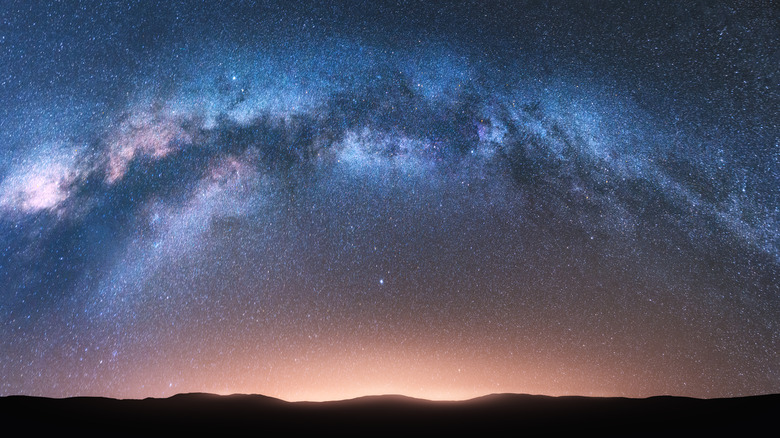What's The Shape Of The Universe?
It must have made sense for ancient peoples to look at the sky and think, "We are at the center of the universe." After all, the sun rose in the east, set in the west, and right in the seeming middle sat people. To them, it was simple observation. The "cradle of civilization" in ancient Mesopotamia from 3,000 – 1,000 BCE or so — Akkadia, Sumer, Babylon, and other empires and kingdoms — was intensely preoccupied with creation myths, the gods, and most pointedly, how it all connected to crops and staying alive, as the Metropolitan Museum of Art overviews.
Ancient Egypt had similar cosmological preoccupations, and so did practically everyone else. The astronomer Galileo launched the modern era of telescope-wielding astronomy in 1609 (per The Great Courses Daily), and 300 years later in 1929, the Hubble Constant was first calculated to measure the rate of the expansion of the universe (per the BBC). Now we know that the universe is nonsensically huge: 2 trillion galaxies each containing at least around 100 billion stars (per the Conversation). Our sun is just one of them.
All of this — all of reality — sprang from the infinitely dense point of the Big Bang. From Earth, looking up, the universe looks like an inflating balloon dotted with ink for stars. Everything expands outward, and each thing drifts from all other things. But does that mean that the universe is shaped like a sphere? Or something else entirely?
Closed like a sphere?
One of the first brain-breaking questions that a kid might ask is, "But mommy, what's outside the universe?" This question is similar to, "But mommy, who made god?" Both questions are likely to make a parent reach for the nearest keys and start dangling them in the air. To the latter question we say: your call how to answer. To the former question we say: nothing.
That's right: nothing. The universe isn't stuffed into, or wrapped in, another something, around which something else wraps, ad infinitum. Our balloon analogy breaks down here: there's no outer side to the inflating balloon wall of the universe. There's only an inner surface (so to speak). This means that there's no "edge" to the universe, only a continual, concave, "positive curvature" like the inside of a contact lens. There's no true beginning or end point, only a finite surface to surf.
That is, if the universe is shaped like a sphere. As Space explains, it all depends on the Hubble Constant, which measures space's expansion. Reason being, space bends according to how much mass is inside it. A dense object like the sun is like a tennis ball on a stretched bedsheet, and the Earth a marble. With enough "stuff" inside the universe, enough mass, the universe would curve around, close in on itself, and take the shape of a sphere. Attractive forces, including dark matter, would eventually halt the universe's expansion, and even cause it to collapse again.
Flat like a carpet?
Remember that the scale of the universe is so vast — 2 trillion galaxies, right? (per Futurism) — that we can only perceive any "curves" to its shape from a far enough distance. Even on Earth's surface, it's not obvious that we're standing on the outside of a spheroid unless we travel high enough into the atmosphere. That's why we can talk about the shape of the entire universe in simple 2D and 3D geometric terms.
To the point: what about a "flat" universe, like a carpet? This is where things get brain-bendy (bear with us). A flat universe has no edges, no boundaries, and extends toward infinity. The expansion would slow, but never stop, as Seeker puts it on YouTube. This would happen if the universe has just the right amount — the perfect, precise amount, as measured by the Hubble Constant — to neither curve in on itself nor bow outward like a horse saddle (more on that later). Now, you might be thinking: well, what if I travel "up" from the carpet? Wouldn't I hit a boundary? No, because the flat plane, like the inside of a sphere, expands in all directions, including its "thickness."
For a long time, researchers thought this was the case. As Phys describes, "cosmic background radiation" — energy signatures leftover from the Big Bang — are relatively even across the entire observable universe. This could only happen if the universe's initial inflation happened really, really quickly.
Inverted like a saddle?
There's a final option for the shape of the universe. Not curved and "closed" like a sphere, not flat like a carpet, but curved and "open" like a horse saddle. Keep extending the saddle shape to either side, and the saddle becomes, well... a donut. A ring. And lo and behold, as Phys says, the most recent research indicates that we could indeed be living in a donut-shaped universe. We just hope it's got sprinkles.
In the saddle-donut scenario, there's not enough mass to halt the universe from expanding, using the Hubble Constant, similar to a flat universe. Dark energy fuels the ever-quickening expansion of the universe, as NASA says. But similar to a closed universe, this universe's shape would eventually wrap around itself. If you could somehow travel faster than the rate of the universe's expansion and could coast along its convex exterior, you'd eventually wind up back at the beginning. This is called "negative curvature."
As it turns out, this is the likely scenario, at least ever so slightly (as Seeker on YouTube explains). It's difficult to perceive the negative curvature of the cosmos because the observable universe — what we can see — is so, so tiny, as Discover Magazine relates. Just like someone standing on Earth, its curved surface isn't obvious to the naked eye. But both the flat and saddle-donut universes reach a state of eternal frost because matter becomes so spread out. This is called the Big Freeze.



